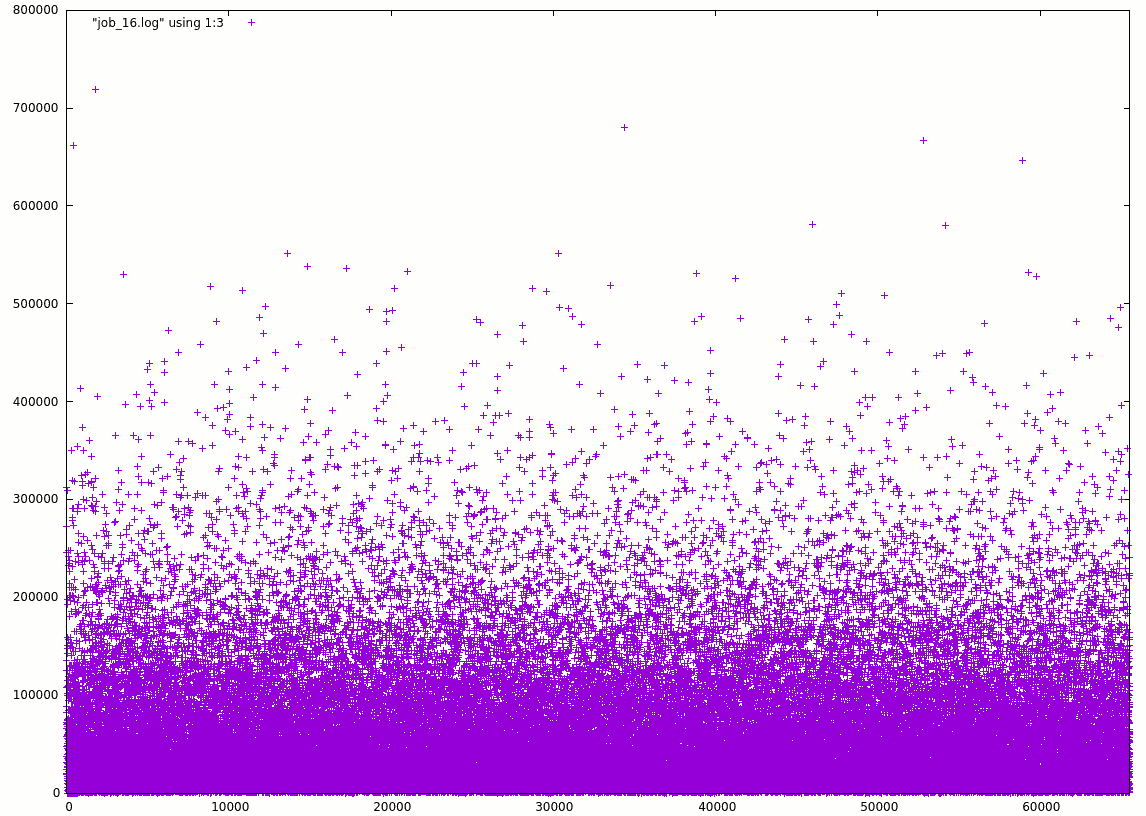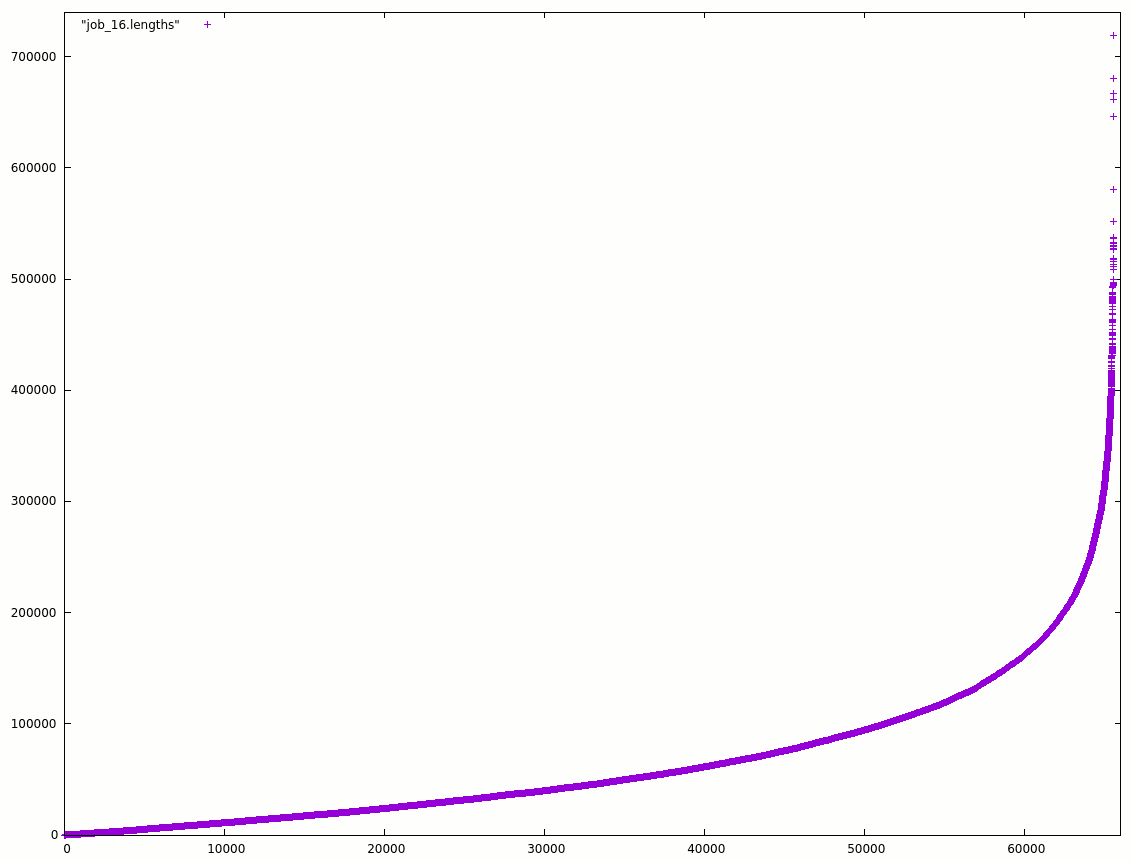Following the previous log An individual job and all the necessary processing, I wrote the program gold_01.c to check the behaviour before I increase parallelism.
First thing it did was confirm that the result C=1 occurs only when the result X=0. So we can save/ignore this data point.
Let's now look at the output for the smallest job: w=3
1 6 6 2 0 11 3 2 5 4 5 3 5 3 4 6 4 5 7 7 35
This one is quite weird because 7 loops back to 7 in 35 cycles but we can follow the primary loop easily :
1 -> 6 -> 4 -> 5 -> 3 -> 2 -> 0
And since 0 is reached with C=1, it goes back to 1 in 7 crossings (and 29 steps, w3 is clearly asymmetrical).
From there, it's very easy to script for the other sizes.
$ for i in 3 4 5 6 7 8 9 10 11 12 13 14 15 16 17 18 19 20
do echo -n "$i: "
gcc -Wall -DWIDTH=$i -Os gold_01.c -o gold
/usr/bin/time ./gold > job_$i.log
done
3: Total: 69
0.00user 0.00system 0:00.00elapsed 91%CPU (0avgtext+0avgdata 1424maxresident)k
4: Total: 269
0.00user 0.00system 0:00.00elapsed 87%CPU (0avgtext+0avgdata 1384maxresident)k
5: Total: 797
0.00user 0.00system 0:00.00elapsed 93%CPU (0avgtext+0avgdata 1392maxresident)k
6: Total: 4157
0.00user 0.00system 0:00.00elapsed 94%CPU (0avgtext+0avgdata 1428maxresident)k
7: Total: 16079
0.00user 0.00system 0:00.00elapsed 90%CPU (0avgtext+0avgdata 1368maxresident)k
8: Total: 23114
0.00user 0.00system 0:00.00elapsed 90%CPU (0avgtext+0avgdata 1316maxresident)k
9: Total: 258059
0.00user 0.00system 0:00.00elapsed 0%CPU (0avgtext+0avgdata 1320maxresident)k
10: Total: 1049597
0.00user 0.00system 0:00.00elapsed 50%CPU (0avgtext+0avgdata 1388maxresident)k
11: Total: 4190147
0.00user 0.00system 0:00.00elapsed 83%CPU (0avgtext+0avgdata 1524maxresident)k
12: Total: 16781251
0.03user 0.00system 0:00.03elapsed 96%CPU (0avgtext+0avgdata 1548maxresident)k
13: Total: 67117049
0.08user 0.00system 0:00.09elapsed 98%CPU (0avgtext+0avgdata 1512maxresident)k
14: Total: 268451737
0.36user 0.00system 0:00.36elapsed 99%CPU (0avgtext+0avgdata 1624maxresident)k
15: Total: 1070073927
1.43user 0.00system 0:01.44elapsed 99%CPU (0avgtext+0avgdata 1928maxresident)k
16: Total: 4295032829
4.96user 0.00system 0:04.97elapsed 99%CPU (0avgtext+0avgdata 2396maxresident)k
17: Total: 17179997009
23.58user 0.01system 0:23.64elapsed 99%CPU (0avgtext+0avgdata 3352maxresident)k
18: Total: 68719736689
110.75user 0.03system 1:51.12elapsed 99%CPU (0avgtext+0avgdata 5528maxresident)k
19: Total: 274803255069
486.96user 0.11system 8:09.19elapsed 99%CPU (0avgtext+0avgdata 9612maxresident)k
20: Total: 1099443499868
1880.05user 0.36system 31:27.70elapsed 99%CPU (0avgtext+0avgdata 17692maxresident)k
Of course, past w16, the running time and the memory explode.
Interestingly, the number of total iteration quadruples for each increment of w but the total size of the file only doubles:
44 10 juil. 00:50 job_3.log
113 10 juil. 00:50 job_4.log
251 10 juil. 00:50 job_5.log
557 10 juil. 00:50 job_6.log
1226 10 juil. 00:50 job_7.log
2753 10 juil. 00:50 job_8.log
5921 10 juil. 00:50 job_9.log
12423 10 juil. 00:50 job_10.log
27659 10 juil. 00:50 job_11.log
58670 10 juil. 00:50 job_12.log
122025 10 juil. 00:50 job_13.log
264080 10 juil. 00:50 job_14.log
559598 10 juil. 00:50 job_15.log
1161492 10 juil. 00:50 job_16.log
2449479 10 juil. 00:51 job_17.log
5194057 10 juil. 00:53 job_18.log
10763126 10 juil. 01:01 job_19.log
22192296 10 juil. 01:32 job_20.log
The raw data (19MB) is available here if you don't want to spend 1/2h to compute the larger ones.
I visualised the output data with gnuplot. Here is a plot of the length of the arcs of w16:

It looks quite random and the lengths range from 3 to 718818, or about 11× the number of arcs (that's not excessive).
Here is the distribution (obtained by sorting the lengths):

Does that make it an exponential curve ?
Half of the arcs are shorter than 45000, or about 2/3 of the size.
Of the 65535 arcs, only 19746 are duplicates (about 1/3).
__________________________________________________
Let's see with w4:
1 7 23 2 11 6 3 13 42 4 10 14 5 14 9 6 15 14 7 8 10 8 9 3 9 4 31 10 2 20 11 5 8 12 6 34 13 12 25 14 0 10 15 3 20
There are 2 orbits:
Primary orbit: 1 -> 7 -> 8 -> 9 -> 4 -> 10 -> 2 -> 11 -> 5 -> 14 -> 0 -> 1 : 11 arcs 23+10+3+31+14+20+6+8+9+10+1 = 135 Secondary orbit: 15 -> 3 -> 13 -> 12 -> 6 -> 15 : 5 arcs 20+42+25+34+14 = 135
The sums match previous tests but we see that the number of arcs varies a lot.
 Yann Guidon / YGDES
Yann Guidon / YGDES
Discussions
Become a Hackaday.io Member
Create an account to leave a comment. Already have an account? Log In.